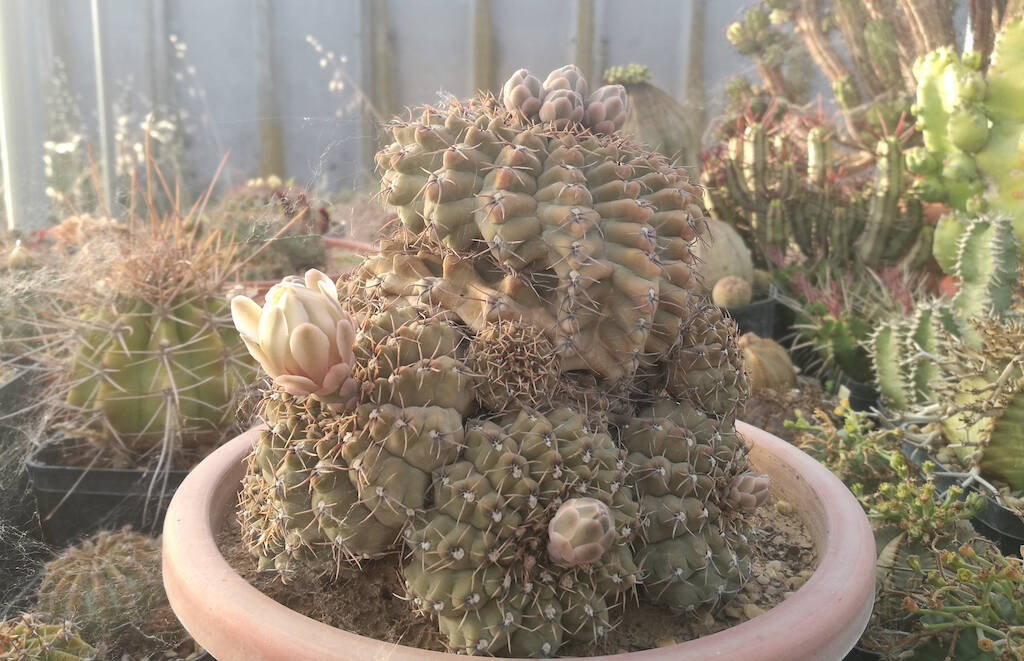Let’s talk about cactus pups o cactus suckers. Some call them “branches”, others call them “new heads”. Some, more prosaically, call them “children” of the mother plant or “pups”. In all cases, they are new “protuberances” that sprout around the body of the main plant.
In cacti, as well as in agaves, this is a common phenomenon, and in some species, it never happens, in others it very easily happens, even with young plants. Attention: we are not talking about true seedlings born under the stem of the mother plant from seeds that have fallen from the latter, but about authentic new bodies that are attached to the main stem and sprout from the latter, and then grow steadily in size. The correct term is “suckers”, and anyone who grows cacti or has looked at this plant family in a nursery or botanical garden will have seen one or more suckers. Why do cacti produce suckers or pups, which genera are more likely to suck and are less so? And again, the most frequently asked question: is it true that pups steal energy from the mother plant and reduce flowering? Can the suckers themselves blossom? Another frequently asked question: is it better to leave them attached to the mother plant or remove them? Can they be used as cuttings to obtain new plants identical to the mother plant, and in the event of disease of the latter, can they be detached to save it and reproduce it? In other words, how to propagate cactus pups?
In this article, we take a closer look at the subject and answer all these questions (…).
Some premises to frame the topic
In order to frame the topic, let us start with the definition of “sucker” (or pups) taken from the booklet “Conoscere e Coltivare le Piante Succulente” (Knowing and Growing Succulent Plants) published in 2005 by the Italian Succulent Plant Lovers Association (AIAS). The glossary at the end of the booklet, under the heading “sucker”, reads: “Branch usually originating from an adventitious bud“. Let us supplement the description with the one given by Treccani online encyclopedia to the term “adventitious” so as to get the full picture: “An adventitious organ is said to be formed far from the vegetative apex of the axis and therefore on adult parts; as opposed to normal“.
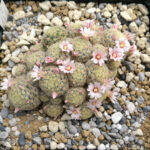
So, talking about the sphere of cacti, it can be stated that cactus pups or cactus suckers are nothing more than branches originating from the main stem, born from adventitious buds, i.e. not at the plant’s apex. It is not by chance that the suckers are always located at the base of the main stem. Growing around it and contributing to giving the cactus the “tufted” habit that we are accustomed to seeing in, for example, Echinopsis, many Mammillaria, Rebutia and Sulcorebutia, to offer just a few examples. The phenomenon of suckering is also common in Agave: even relatively small specimens soon begin to produce suckers around the base, through which the plant can be easily multiplied.
The shapes of cacti: a specific article.
Therefore suckers are branches, not autonomous plants born from seeds originating from the mother plant, nor deformations of the stem. They are offshoots of the plant, which develops and grows in this way. The suckers (or pups), in fact, are attached to the mother plant. In some cases, the point of contact is extremely thin and delicate, so much so that a slight twisting of the sucker is sufficient to detach it. In other cases, especially after years, the point of contact is strong, and to take off the sucker it is necessary to cut it off.
The fascinating thing is that often the suckers behave as “abnormal” branches, in the sense that they do not simply develop while remaining dependent on the mother plant but produce autonomous roots themselves. This is particularly the case in cacti having a globular habit, which, thanks to the development of suckers, take on a bushy habit over time (e.g. Echinopsis). Proper branches, on the other hand, are generally produced by columnar cacti. This usually happens over a very long period of time and, in some species, exclusively in the wild, as with Carnegiea Gigantea (the so-called Saguaro).
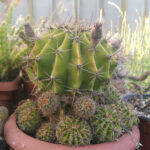
Over the years, I have witnessed, particularly with Echinopsis, a particular phenomenon, the cause of which is not known to me: in long-since suckered specimens, the main stem has begun to wither and then dry up completely. On the contrary, the suckers around the mother plant have always remained in perfect health, so much so that all I had to do was to take them off and re-pot them (over time, they had produced perfect root systems) to save the plant and at the same time multiply it. All the plants to which this phenomenon happened were healthy and not subject to any attack by pests, and the central stem did not show any traces of rot (also because, in that case, it would soon have transmitted it to the suckers). Rather, it seemed to me that the central body, having exhausted its function as a ‘producer’ of branches, had just finished its life cycle, thus deciding to “take off the trouble” and let the descendants grow… In such cases, more for a simple aesthetic factor than anything else, I flared the plant, detached the suckers and re-potted them, throwing away the central stem, now dry and dead.
The function of cactus pups
Suckers or pups, again remaining in the Cactaceae family, are branches, as we have seen, so their function is no other than that which follows the plant’s normal development. Many cacti initially have a globular habit, with a single stem. At a certain point in their development, however, the plant begins to emit one or more branches, which over time grow to the same size (in many cases, not always!) as the main stem. As the years go by, the pups increase not only in volume, but also in number, and give the plant its typical tufted appearance. Here again, the most common example is Echinopsis. Therefore, it is incorrect to say that the suckers serve the plant to multiply since they are attached to the main stem and are only its extension. It is clear, however, that if for some reason (the passage of an animal, a storm, etc.), a sucker detaches itself, moves away from the mother plant and begins to sink its roots into the soil, it can perform the function of “reproducer” of the plant. This is what we can do by manually detaching the suckers and re-potting them in separate containers, with the effect to grow more plants (I will discuss this in more detail later).
Do all cacti produce pups or only some species do?
Absolutely not. Not all genera of cacti are prone to producing suckers. Even within the same genus, there may be species that readily suck and others that retain a single stem even as they age (e.g. the genus Mammillaria). Plants with a solitary stem that almost never suckers are, for example, those belonging to the genera Ferocactus, Astrophytum, Echinocactus, Copiapoa, Epithelantha, Turbinicarpus, Ariocarpus, Ancistrocactus. Beware, these are broad indications, because, in reality, any Cactaceae could emit suckers. If it does not do so because of a genetic issue, it could still do so because of an external factor. Which brings us to another question: can suckers depend on abnormal growth?
Abnormal growth and cactus pups: the differences
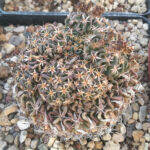
Even cacti that would not produce suckers except at a very old age, as some Echinocactus and Copiapoa, can suck as the effect of abnormal development of the main stem. This phenomenon always follows an episode of stress (environmental or “mechanical”). In other words, the plant reacts to unsuitable growing conditions by emitting suckers (probably to give itself a better chance of survival). Similarly, and very frequently, a cactus can begin to sprout pups following a parasite attack (mealybug, spider mite) or after a mechanical trauma such as a blow (moving or re-potting a plant can always happen, and it can get out of hand…). In all these cases, especially if the damage is near the apex, the plant may take on a habit that is not typical for that species and emit suckers. It has happened to me several times with Astrophytum, Copiapoa and Turbinicarpus: plants that, under normal conditions, would not produce suckers except at a very advanced age.
An important question: do suckered plants flower less?
One of the most widespread beliefs among succulent enthusiasts is this: the suckered plants do not flower or flower less than single-stemmed plants. This is a mistaken belief. It is clear that the suckers absorb water and energy together with the mother plant, and therefore both water and energy must be shared between several subjects, but it is equally clear that, since they are branches, everything contributes to the common cause, i.e. to the development of the plant, whether it is a clumped or a solitary plant. It may be the case that in the initial phase when the suckers are still small, the mother plant will flower less profusely, but we take into account that once the suckers have grown, they will begin to bloom, contributing to the overall result.
As far as my own experience is concerned, for about thirty years I have never seen any significant reduction in the flowering of suckered plants. I have several plants of the same genus and species, and when a single specimen flowers, the suckered specimen of the same species also flowers. In all these cases, there is little or no difference in flowering. In short: I have never had single plants with ten flowers and suckered plants (obviously of the same species and obtained from the same sowing) with only one. On the contrary, it happens to me every year that in the rectangular pot full of Echinopsis oxygona that I keep on my balcony at home, the many heads produce 15 to 20 flowers at a time.
One thing, however, can be said with relative certainty: the suckered plant has less vigorous and slower growth than the plant without suckers. In other words, if the specimen is surrounded by suckers, the same genus and species growth will be less noticeable overall, as it is spread over several bodies. If the plant is solitary, it is clear that it will concentrate all its energy on the single stem, with the result that growth will appear more evident and faster.
Is it better to keep suckers or to detach them?
When we talk about cactus pups, one of the most common questions is: is it better to keep them or to detach them? If we think about it, it is a question whose only sense can be found in the aesthetic sphere. Whether a cactus produces suckers because it has suffered damage, or whether it produces them simply because it decides that this is what it must do, does not change the substance: the plant is just following the course of Nature.
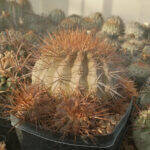
The only answer to the question “is it better to leave the suckers or remove them” can only be: it is an aesthetic question. If you prefer the plant with a solitary stem, you can remove the suckers and use them as cuttings to reproduce the plant. If, on the other hand, you like the plant tufted, leave it to nature. Be careful, however: if you want to remove the suckers, only do so if they detach easily from the mother plant. If it is necessary to cut, e.g. because the sucker is very old and the junction point with the main stem is wide, it is necessary to cut exactly as we would do with a cutting, i.e. with a disinfected blade and taking care to sprinkle the wounds with healing powder (even ordinary cinnamon powder is fine), both on the mother plant and on the sucker. Apart from the aesthetic factor, which for me also includes the “philosophical” one (because I prefer to leave it to nature, exactly as would be with the specimen in its habitat), there may be two valid reasons for detaching all (or only some) suckers. If a sucker is rotting, for example, it is obvious that we should remove it as soon as possible to prevent it from transmitting the fungus to the mother plant or the other suckers. Similarly, but in reverse, if the main stem is rotting or withered, it will be better to remove all the suckers and save at least those.
The second reason why it may be a good idea to detach one or more suckers is for the quick reproduction of the plant. In this case, it is enough to wait until the sucker is well-formed and has taken root. At that point, we can detach it and thus have one or more clones of the mother plant.
How to reproduce the plant by suckers and how to propagate cactus pups
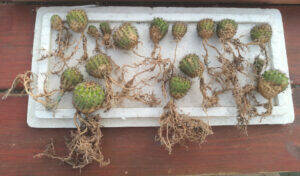
Reproduction by suckers is a reproduction by cuttings: a piece of the plant is used to obtain a clone. With suckers, it is easier because (if we are not in a hurry) they are already formed and rooted plants. The procedure is very easy, especially if carried out during re-potting and with the mother plant unplanted. Detach the sucker by rotating it on its axis until the point of connection with the main stem gives way. If the connection with the mother plant is firm, it will be necessary to cut it off cleanly with a cutter. Once the sucker is detached, leave the mother plant in an airy place and avoid watering and misting for at least ten days so that the wound heals. We do the same with the sucker: leave it in a shady, airy place so that the junction with the mother plant dries out completely, just like the roots. After a week or two, re-pot the sucker in common cactus soil and wait a few more days before watering.
The best time for these operations, as the plant is reproducing, is late spring, after the plant has started to vegetate again. In this season, the suckers will be active and take root easily. The operation is to be avoided during the winter unless it is necessary to save the mother plant or the sucker.
SUBSCRIBE TO THE SITE – If you liked this article, subscribe to the site to have access to all the contents for one year or three months depending on the formula you choose. Here you will find terms and conditions.
SUBSCRIBE TO THE NEWSLETTER – If you want to receive the free newsletter every time new content is published (even if you have not subscribed to the site), fill in the fields at this link!
Correlated articles
How much light do cactus need? A summary table
How to repot cacti and succulent plants
Substrates for cacti and succulents
The correct soil: the materials you can use
When and how fertilize cactus and succulent plants
© The texts, videos, photos and graphic elaborations of the site “Il fiore tra le spine” are original material and are covered by copyright. It’s forbidden to reproduce them in any way.


